Pandas: Select the Rows where two Columns are Equal
Last updated: Apr 12, 2024
Reading time·4 min

# Table of Contents
- Pandas: Select the Rows where two Columns are Equal
- Pandas: Select the Rows where two Columns are NOT Equal
- Pandas: Select the Rows where two Columns are Equal using df.query()
- Pandas: Select the Rows where two Columns are NOT Equal using df.query()
# Pandas: Select the Rows where two Columns are Equal
To select the rows where two columns are equal in a Pandas DataFrame:
- Use the
DataFrame.locindexer for indexing based on a boolean array. - Specify a condition that compares the cell values of column
Avs columnB.
import pandas as pd df = pd.DataFrame({ 'A': ['Alice', 'Bobby', 'Carl', 'Dan'], 'B': [10, 20, 30, 50], 'C': [10, 15, 30, 25], }) print(df) cols_equal = df.loc[(df['B'] == df['C'])] print('-' * 50) print(cols_equal)
Running the code sample produces the following output.
A B C 0 Alice 10 10 1 Bobby 20 15 2 Carl 30 30 3 Dan 50 25 -------------------------------------------------- A B C 0 Alice 10 10 2 Carl 30 30
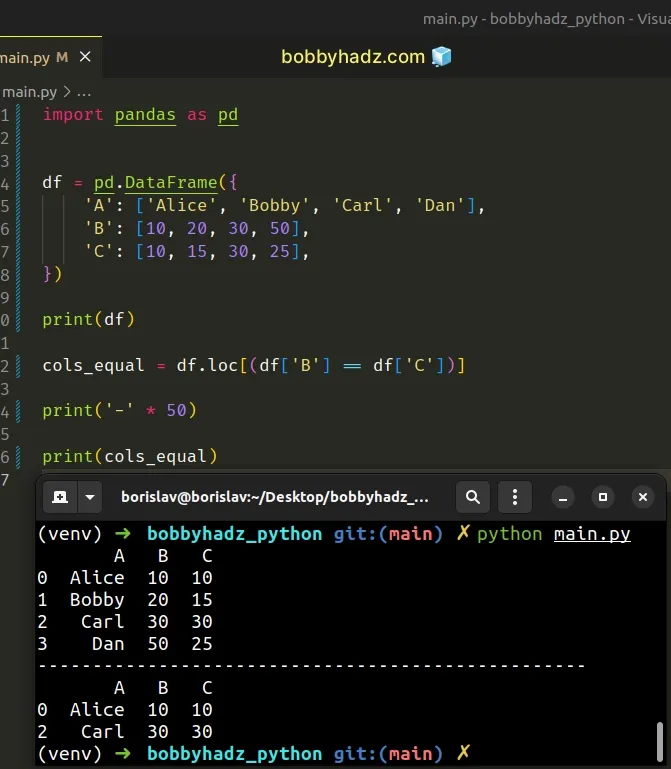
The condition returns a Series with True values for all matching elements
and False for all elements that don't match.
import pandas as pd df = pd.DataFrame({ 'A': ['Alice', 'Bobby', 'Carl', 'Dan'], 'B': [10, 20, 30, 50], 'C': [10, 15, 30, 25], }) # 0 True # 1 False # 2 True # 3 False # dtype: bool print(df['B'] == df['C'])
If the corresponding rows in columns B and C are equal, then the index of
the Series is set to True.
The last step is to use the
DataFrame.loc indexer to
access the group for rows for which the condition returns True.
import pandas as pd df = pd.DataFrame({ 'A': ['Alice', 'Bobby', 'Carl', 'Dan'], 'B': [10, 20, 30, 50], 'C': [10, 15, 30, 25], }) cols_equal = df.loc[(df['B'] == df['C'])] # A B C # 0 Alice 10 10 # 2 Carl 30 30 print(cols_equal)
# Pandas: Select the Rows where two Columns are NOT Equal
If you need to select the rows where two columns are not equal, use the
inequality != operator.
import pandas as pd df = pd.DataFrame({ 'A': ['Alice', 'Bobby', 'Carl', 'Dan'], 'B': [10, 20, 30, 50], 'C': [10, 15, 30, 25], }) print(df) cols_not_equal = df.loc[(df['B'] != df['C'])] print('-' * 50) # A B C # 1 Bobby 20 15 # 3 Dan 50 25 print(cols_not_equal)
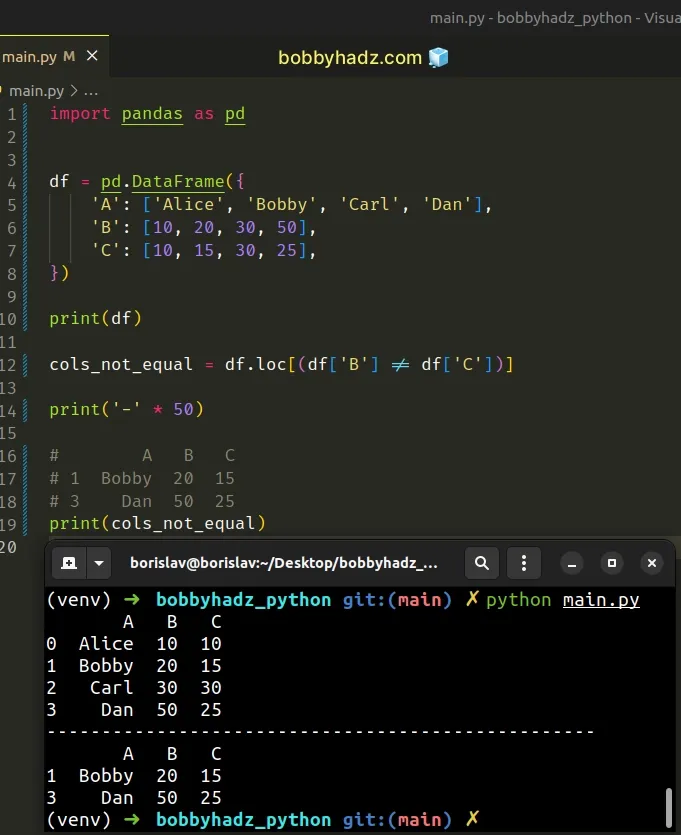
The example selects the rows where the cell value in column B is not equal to
the one in column C.
Notice that we used the inequality operator != and not the equality ==
operator.
You can achieve the same result by using
the tilde ~ operator
to negate the result of the comparison.
The following code sample also selects the rows where two columns are NOT equal.
import pandas as pd df = pd.DataFrame({ 'A': ['Alice', 'Bobby', 'Carl', 'Dan'], 'B': [10, 20, 30, 50], 'C': [10, 15, 30, 25], }) print(df) cols_not_equal = df.loc[~(df['B'] == df['C'])] print('-' * 50) # A B C # 1 Bobby 20 15 # 3 Dan 50 25 print(cols_not_equal)
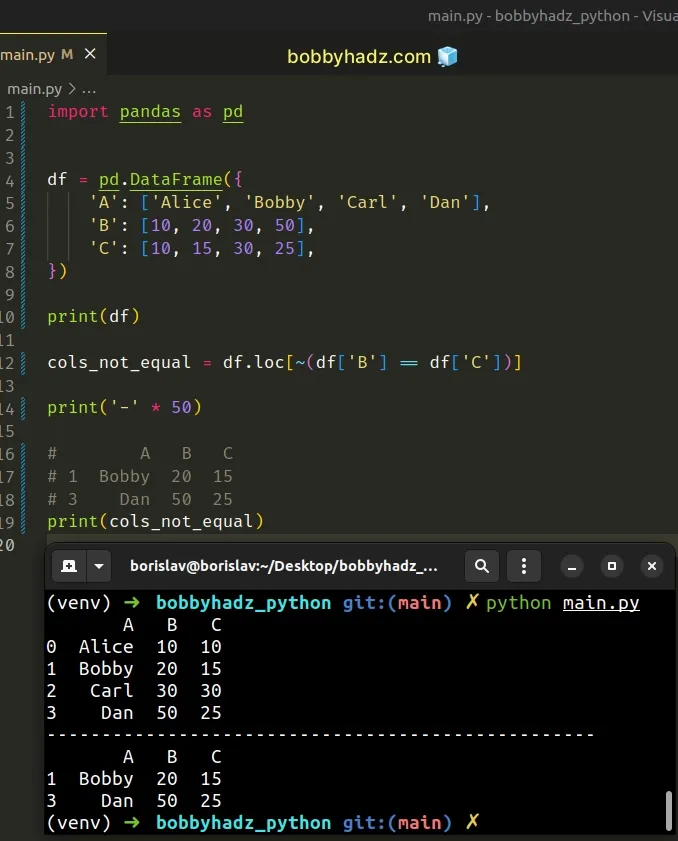
The tilde ~ operator is used to toggle each boolean value (True becomes
False and vice versa).
import pandas as pd df = pd.DataFrame({ 'A': ['Alice', 'Bobby', 'Carl', 'Dan'], 'B': [10, 20, 30, 50], 'C': [10, 15, 30, 25], }) print(~(df['B'] == df['C'])) print('-' * 50) print(df['B'] == df['C'])
Running the code sample produces the following output.
0 False 1 True 2 False 3 True dtype: bool -------------------------------------------------- 0 True 1 False 2 True 3 False dtype: bool
When using the tilde ~ operator, you have to make sure to wrap the condition
in parentheses so that it is applied to the entire expression.
print(~(df['B'] == df['C']))
# Pandas: Select the Rows where two Columns are Equal using df.query()
You can also use the DataFrame.query() method to select the rows where two columns are equal.
import pandas as pd df = pd.DataFrame({ 'A': ['Alice', 'Bobby', 'Carl', 'Dan'], 'B': [10, 20, 30, 50], 'C': [10, 15, 30, 25], }) cols_equal = df.query('B == C') # A B C # 0 Alice 10 10 # 2 Carl 30 30 print(cols_equal)
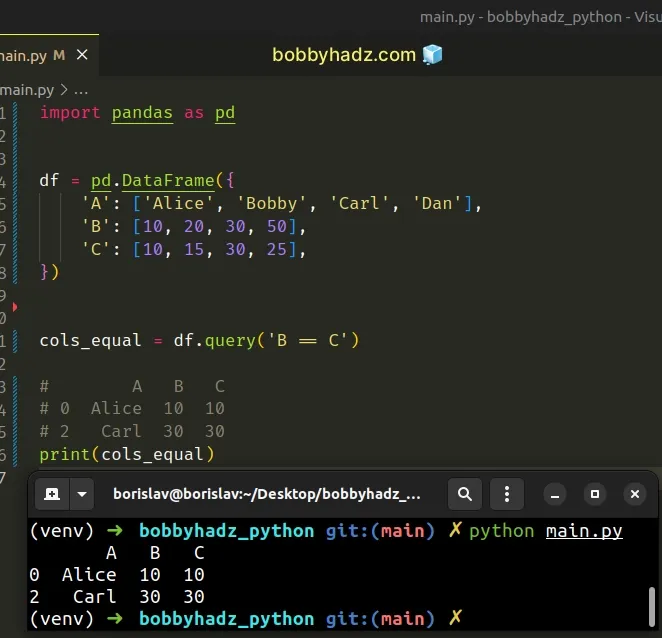
The
DataFrame.query()
method enables us to query the columns of the DataFrame with a boolean
condition.
The code sample compares the values in the B and C columns and returns a new
DataFrame that only contains the matching rows.
# Pandas: Select the Rows where two Columns are NOT Equal using df.query()
You can also use the DataFrame.query() method to select the rows where two
columns are NOT equal.
import pandas as pd df = pd.DataFrame({ 'A': ['Alice', 'Bobby', 'Carl', 'Dan'], 'B': [10, 20, 30, 50], 'C': [10, 15, 30, 25], }) cols_equal = df.query('B != C') # A B C # 1 Bobby 20 15 # 3 Dan 50 25 print(cols_equal)
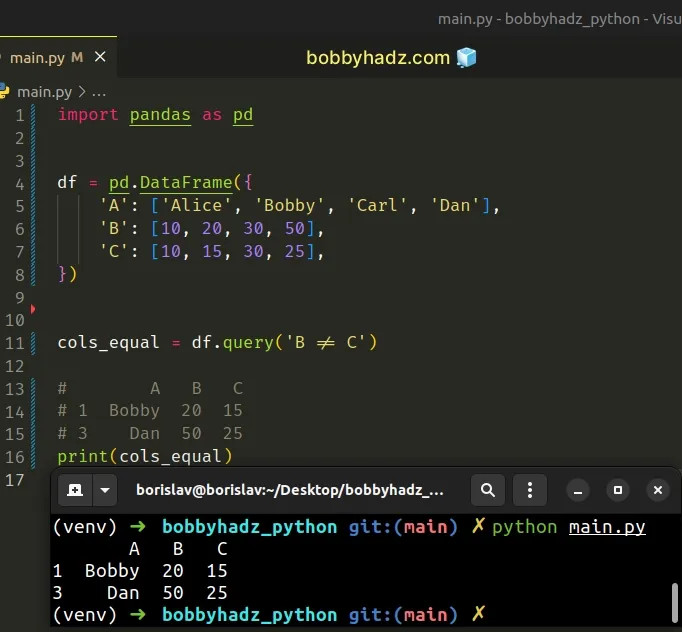
We used the inequality operator != to select the rows where the cell values in
column B are not equal to those in column C.
# Additional Resources
You can learn more about the related topics by checking out the following tutorials:
- Pandas: Cannot setitem on a Categorical with a new category
- Only valid with DatetimeIndex, TimedeltaIndex or PeriodIndex, but got an instance of X
- Pandas ValueError: ('Lengths must match to compare')
- Pandas SpecificationError: nested renamer is not supported
- Cannot perform 'rand_' with a dtyped [int64] array and scalar of type [bool]

